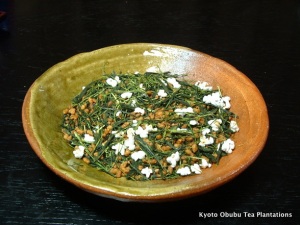Leaf Type: Green
Where to Buy: Obubu Tea
Product Description:
Otsukimi (お月見) literally means “moon viewing” and is closely associated with Japanese festivals celebrating the moon in Autumn. It is at this time of the year when the moon appears brightest, and Japanese eat certain dishes such as tsukimi dango (round, white dumplings), edamame (soybeans), Japanese chestnuts, etc.
Our Otsukimi Sencha or Sencha of the Autumn Moon was named after this Japanese tradition not only because we harvest it in late September when the festivals occur, but also because the tea leaves and stems produce a bright yellow-green sencha with a round flavor.
Taster’s Review:
On the flavor guide for this tea on the Obubu Tea website, it suggests that the aroma of this tea “reminds you of a full moon.” Now, I don’t know if the aroma actually reminds me of a full moon, or if the mere suggestion evokes the image, but, I will say that the aroma is a pleasant one. Vegetative, but with notes that do remind me of the scent of the evening air on a clear night: the trees, the crisp breeze, and hints of flower in the distance. So, perhaps it does remind me of a full moon, or at the very least, a cool evening in autumn.
The tea brews to a rather murky shade of green, not an unpleasant color, but not the bright green that I often achieve from brewing a Sencha tea.
But do not let that sway you, because the flavor is delightful. It is rich and vegetative with a nutty undertone. There is an intriguing bittersweet flavor to this cup. Not a bad “bitter” – but a savory one that perks the taste buds right up and calls upon them to take another sip to experience the taste yet again.
The taste is very fresh and slightly grassy, which is something I’ve come to expect from a good quality Sencha such as this, however, this one doesn’t possess that sweet butter taste of some other Sencha teas, this one is more of a bittersweet kind of Sencha, making this an ideal choice for those who find that buttery feel and taste a little off-putting. The finish offers a very light astringency. The aftertaste is clean and lightly sweet with hints of flower and grass.
The tea has a very well-rounded flavor; very palate pleasing! Overall, a very enjoyable cup of Sencha!
Kabuki Tea from American Tea Room
Where To Buy: American Tea Room
Product Description:
Our Kabuki green tea is as dramatic and colorful as its namesake. Small bright kabuse leaves, blossomy cherry tree flowers and vibrant violet blooms come together for a bold, flowery bouquet with a scent of cherry simple syrup. The brew is bright, clear, electric lime. It has a flowery aroma with a light, vegetal undertone. The flavor is smooth and sweet – the taste of cherry blossoms is heightened with flavors of violet and fresh-cut flower stems.
Harvested in Kyoto April 2 – 4 and air shipped to insure optimal freshness.
Tasters Review:
I really like the selection that American Tea Room offers! This is the first time I have tried Kabuki tho. I must admit that I have been intrigued by Cherry Blossom-Type Flavored Teas Lately. So I am very happy to try this one! Here is what I found…
The dry blend smells like Cherry Candy and post infusion it smells like cherry blossoms and green tea. This is a very fun and fruity yet pleasant aroma!
It’s highly flavored – on the tongue – and pretty good hot. Once it turns cold I find it a bit bitter….not in a bad way – just noticed a flavor change when it cools, that’s all. I don’t mind it cold but prefer this hot, actually.
All-in-All this is a fairly good flavored green and I’m happy to add it to my personal stash!
Genmaicha from Kyoto Obubu Tea Plantations
Tea Information:
Leaf Type: Green
Where to Buy: Kyoto Obubu Tea Plantations
Company Description:
Made with a little bit of luxury, Obubu’s Genmaicha (玄米茶) or Brown Rice Tea is made with 100% Japanese-grown sweet mochi rice combined with our Sencha of the Autumn Moon. The strong, sweet flavor of the roasted brown fills the air as the tea steeps and mixes with the sweetness and bitterness of the sencha to produce a delicious and natural tea.
Taster’s Review:
Genmaicha has been a long time favorite of mine. Even when I wasn’t really digging a lot of green teas (there was a time when I was not as enthusiastic about green teas as I am now), I have always found a good cup of Genmaicha to be very enjoyable.
So when I received this sample of Genmaicha, I was very eager to try it. And I am SO glad that I did! This is a delightful Genmaicha – one of the very best I’ve ever tried.
What makes this one significantly different is the Sencha base that is used. Very often, the green tea used to make a Genmaicha is a Bancha. Now, I like Bancha tea quite a bit, and even though Bancha is actually a lower grade of Sencha, Sencha and Bancha teas taste a bit different. Bancha teas tend to have a natural toasted flavor to them that stands out. While some Sencha teas that I’ve tasted do have a slight roasted/nutty quality to them, it is not as prominent as the toasted note that I get from a Bancha.
And these differences in flavor are significant when it comes to Genmaicha. As it is made by blending green tea with toasted and popped rice, there is a roasty-toasty flavor that is one of the most prominent (and appealing) characteristics of a Genmaicha tea. So, when a Genmaicha is blended using a Bancha, you compound that signature roasty-toasty flavor of the Genmaicha. But when a Genmaicha blend is made using a Sencha, the flavor becomes slightly different… slightly more complex.
The backdrop of this tea is a bittersweet flavor – not bitter … but, as I’ve described on Steepster, it is more like semi-sweet to me. It has a pleasant nuttiness that is accentuated nicely with by the popped rice, which has its own natural sweetness. It is very delicious, pleasantly sweet, and extraordinarily delicious!
Attention Genmaicha fans: this Genmaicha is NOT to be missed!



